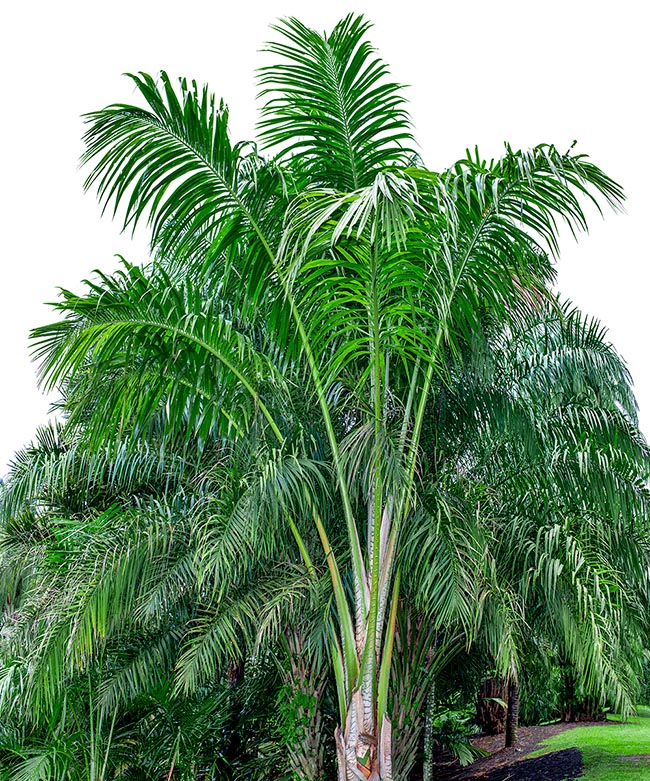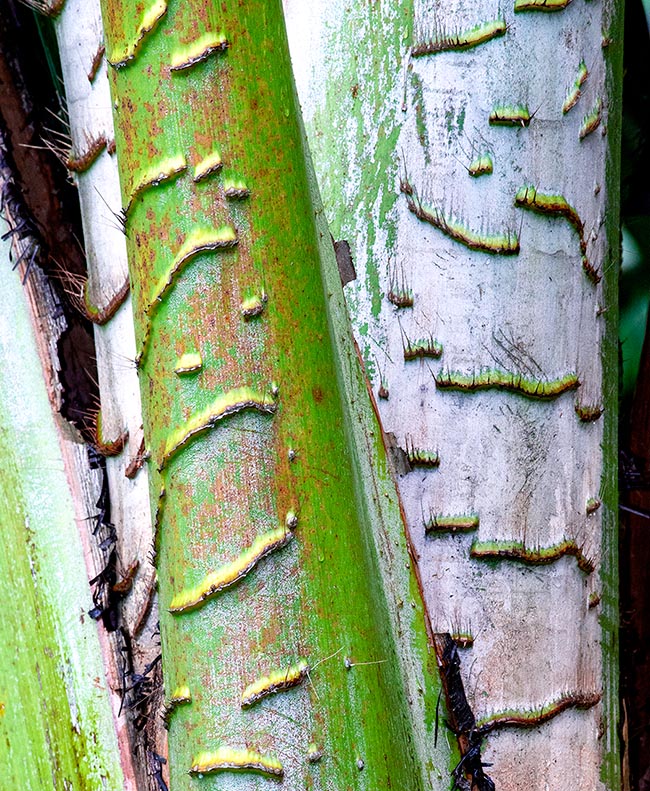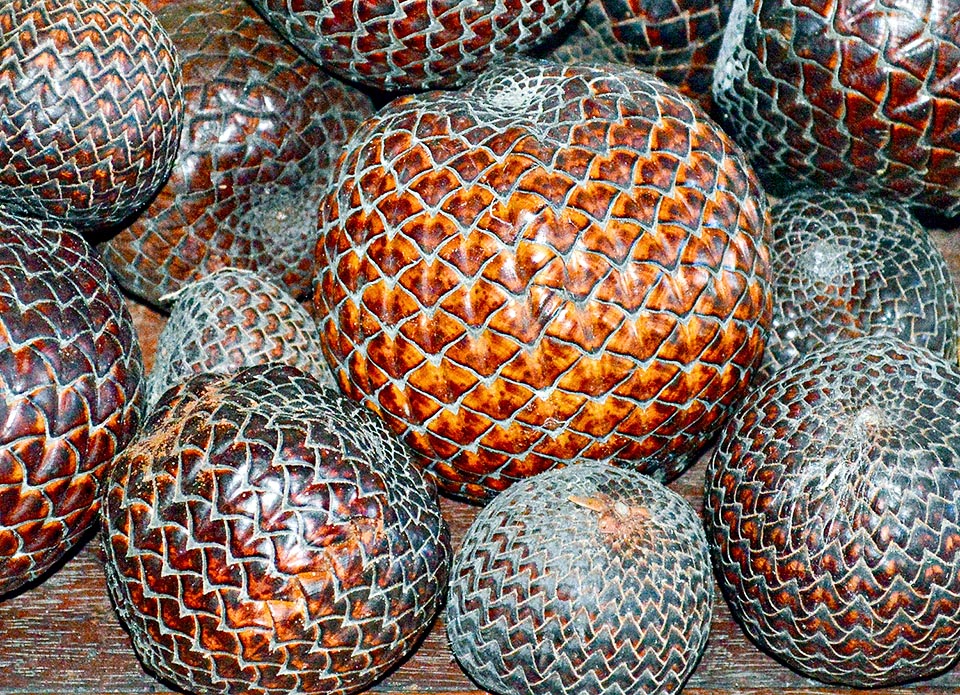Family : Arecaceae

Text © Alessandro Marini

English translation by Mario Beltramini

Metroxylon amicarum is a palm endemic to Caroline Archipelago, where can be 25 m tall © Giuseppe Mazza
Metroxylon amicarum (H.Wendl.) Hook. is a species endemic to the Caroline Islands, where it is distributed mainly in the islands of Ponape and Truk.
It grows in the humid zones of the pluvial forests and in the mountainous areas, up to 700 m of altitude.
The genus name Metroxylon, comes from the Greek terms “metra”, that means “marrow”, and “xylon”, meaning “wood”, with reference to the starch contained inside the stem, utilized for feeding.
The specific term amicarum comes from the Latin and means “of the friends”, with reference to the “Friendly Islands”, now Tonga, from where in a first time the species was thought to come.
Solitary palm with stocky stem up to 25 m tall and even 1 m broad, with visible spaced rings corresponding to the insertions of the fallen old foliar bases. The development of the plant is very fast, seen that the stem can grow even 1 m per year.
The leaves are very big, pinnate, with a tendentially vertical posture, up to 10 m long and even 3 m broad.
The foliar segments can reach 150 cm with a breadth of 10 cm. They are arranged in a V on the rachis, but different angulations, circumstance giving the leaf a feathery look.
The petioles are up to 1 m long and even 30 cm broad, totally covered by characteristic protuberances similar to parallel rings usually bearing, all over their length, small black spines. The inflorescence emerges between the petioles of the leaves: big, ramified, up to 3 m long. The inflorescences are continuously produced all over the year and on the same plant may be found flowers and fruits at different stages of ripening.
Usually the plants take 10 to 15 years to reach the reproductive ripeness.
Metroxylon amicarum is the only species of the genus Metroxylon being not monocarpic, and can bloom regularly for various years before concluding its vegetative cycle.

The even 1 cm long and 30 cm broad petioles, are covered by typical parallel protuberances with thin black spines © Giuseppe Mazza
The fruit is big, roundish, up to 15 cm long and broad, glossy, brown, covered by rhomboid imbricate scales. With time the endosperm hardens till it becomes similar to ivory and forms the so-called vegetal ivory. From this characteristic comes the common name of the species “Ivory nut palm”, or “Palm with the ivory nut”.
Metroxylon amicarum is a very important plant for the local economy of the local populations because it gives their food, medicines and an ample variety of products and material.
From the marrow of the tree they get the sago, a well known starch that forms since ever one of the main food sources for the natives of the islands, where it is widely consumed in the kitchen, especially for preparing typical products in the oven.
The roots, the young leaves and the potions are used in traditional medicine. The parts of the plant are macerated to prepare curative compresses for treating the wounds of the skin.
The leaves are used as cover of the roofs of the dwellings, lasting up to 5 years. The foliar segments are used as straw or interwoven into mats and baskets.
The stems, though not very resistant, are utilized as beams of the houses and as material for building the walls.
The big, very hard seeds, as hard as ivory are used to create a vast range of carved objects and for producing prized buttons.
Given its multiple uses, Metroxylon amicarum is very cultivated in its own origin places, but is little diffused in cultivation in the rest of the world.
Despite the undoubted aesthetic qualities, this species in fact can be admired almost exclusively in the botanic orchards and in the great private collections of the subtropical belt.
Metroxylon amicarum has the cultivation exigencies typical of a tropical palm. It prefers climates with an annual average temperature of 25 °C and does not stand frequent droppings of temperature under 18 °C.

From the tree marrow they get the sago, typical food starch. The fruit is roundish, even 15 cm broad, glossy, brown, covered by rhomboid imbricate scales. With time, endosperm hardens to become similar to ivory. It’s the so-called “vegetal ivory”. Roots, young leaves and petioles are used in traditional medicine © Jimmy Turner
It does not tolerate cold, even if it’s the species of the genus Metroxylon resisting better the thermal changes, but if this conditions lasts a long time, the palm loses its characteristic growing speed and tends to grow faintly. It loves the sunny positions and bears well the winds, even the saline ones. It can grow in an ample range of soils, even if heavy or of poor quality, such as sand or clay, but needs constant water input. Therefore, the ideal position, in cultivation, is close to ponds and water streams.
Metroxylon amicarum is classified as vulnerable in the IUCN red list of the endangered species.
Synonyms: Coelococcus amicarum (H.Wendl.) W.Wight; Coelococcus carolinensis Dingler; Metroxylon carolinense (Dingler) Becc.; Sagus amicarum H.Wendl.
